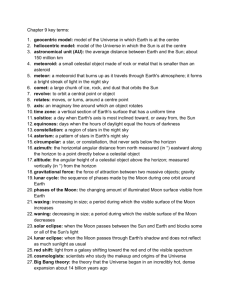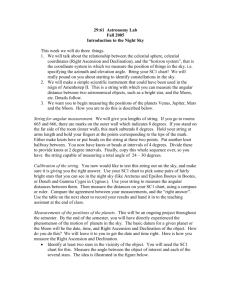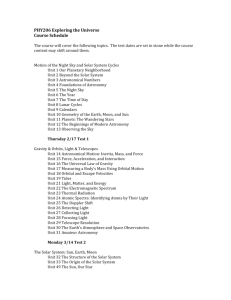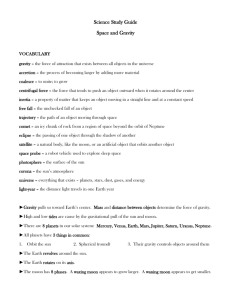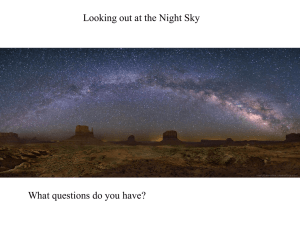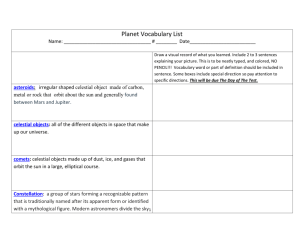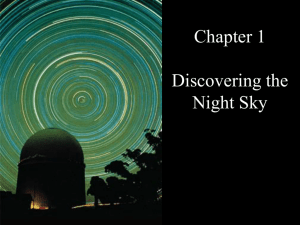1) Give your cosmic "address" in the correct order
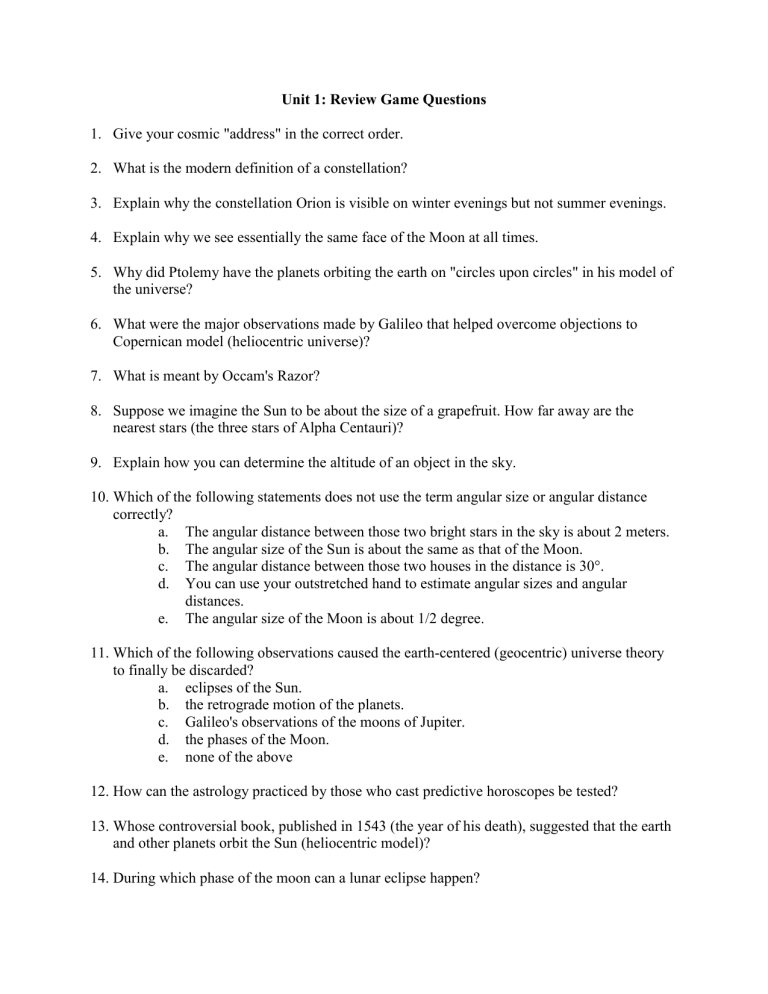
Unit 1: Review Game Questions
1.
Give your cosmic "address" in the correct order.
2.
What is the modern definition of a constellation?
3.
Explain why the constellation Orion is visible on winter evenings but not summer evenings.
4.
Explain why we see essentially the same face of the Moon at all times.
5.
Why did Ptolemy have the planets orbiting the earth on "circles upon circles" in his model of the universe?
6.
What were the major observations made by Galileo that helped overcome objections to
Copernican model (heliocentric universe)?
7.
What is meant by Occam's Razor?
8.
Suppose we imagine the Sun to be about the size of a grapefruit. How far away are the nearest stars (the three stars of Alpha Centauri)?
9.
Explain how you can determine the altitude of an object in the sky.
10.
Which of the following statements does not use the term angular size or angular distance correctly? a.
The angular distance between those two bright stars in the sky is about 2 meters. b.
The angular size of the Sun is about the same as that of the Moon. c.
The angular distance between those two houses in the distance is 30°. d.
You can use your outstretched hand to estimate angular sizes and angular distances. e.
The angular size of the Moon is about 1/2 degree.
11.
Which of the following observations caused the earth-centered (geocentric) universe theory to finally be discarded? a.
eclipses of the Sun. b.
the retrograde motion of the planets. c.
Galileo's observations of the moons of Jupiter. d.
the phases of the Moon. e.
none of the above
12.
How can the astrology practiced by those who cast predictive horoscopes be tested?
13.
Whose controversial book, published in 1543 (the year of his death), suggested that the earth and other planets orbit the Sun (heliocentric model)?
14.
During which phase of the moon can a lunar eclipse happen?
15.
About how many stars are visible on a clear, dark night with the naked eye alone?
16.
The distances to other stars beyond the Sun are measured in:
17.
How do scientists apply the scientific method to the study of our natural surroundings?
18.
A star that always remains above your horizon is called a _________ star.
19.
The Sun's lowest position in the sky occurs at the ________.
20.
The celestial coordinate that corresponds to latitude on the Earth is __________________.
21.
The constellations through which the Sun passes are the signs of the __________________.
22.
The two days when the Sun rises due east and sets due west are the _________________.
23.
The distances within the solar system are best measured in ____________________.
24.
The pseudo science which falsely claims that the positions of the Sun, Moon, and planets can influence our fates is __________________.
25.
For a total solar eclipse to occur, the Moon must be in the ___________ phase.
26.
_______________________ discovered that Jupiter has moons.
27.
_____________developed a system for predicting planetary positions that remained in use for some 1,500 years.
28.
Summarize in your own words, the three "hallmarks" of science?
29.
Explain why many more people witness a total lunar eclipse than a total solar eclipse.
30.
Explain why we have seasons.
31.
True or False: The names of the seven days of the week are derived from the names of the members of the solar system that are visible to the naked eye.
32.
True or False: The seasons on Earth are caused by its elliptical orbit around the Sun.
33.
True or False: You can find the tilt of the earth's axis by measuring the angle between your horizon and the North Star.
34.
True or False: Constellations are close clusters of stars, all at about the same distance from the Sun.
35.
True or False: The autumnal equinox finds the Sun on the equator, heading southward.
36.
True or False: The solstices are the points in the sky where the Sun lies 23.5 degrees above or below the equator.
37.
True or False: The construction of Stonehenge shows definite astronomical alignments.
38.
True or False: Galileo found "imperfections" on the Sun in the form of sunspots and
"imperfections" on the Moon in the form of mountains and valleys.
39.
True or False: Ptolemy invented a geocentric model for planetary motions that persisted over a thousand years.
40.
True or False: The Ptolemaic model of the solar system was useless for predicting planetary positions.
41.
True or False: A light year is the time for light to cross the Earth's orbit.
42.
In local coordinates, the point directly over your head is called the _____________.
43.
The slow wobble of the earth’s axis is called ________________________.
44.
_________________ made the most accurate naked eye measurements of planetary positions; the data was later used by Kepler to developed laws of planetary motion.
46. How long is the precession cycle?
47. What line in the sky is created by our revolution around the sun?
48. Why is there a two day difference in the sidereal and synodic month?
49. The prime meridian of the sky coordinates is the Sun’s position at the ________.
50. Explain why it is so difficult to see planets around other stars.
51. Describe the celestial sphere model and explain how it is used to locate celestial objects.
Review Game Answers
1.
you, Earth, solar system, Milky Way, Local Group, Local Supercluster
2.
It’s one of the recognized regions of the sky that covers the celestial sphere.
3.
This is because of the location of the earth in its orbit.
4.
This is because the Moon's rotational and orbital periods are equal.
5.
He did it to explain the fact that planets sometimes appear to move westward, rather than eastward, relative to the stars in our sky
6.
Galileo saw phases of Venus, Jupiter's moons, craters on the Moon, and sunspots but he could not see stellar parallax (shifting of distant stars because stars are too far away.
7.
This is the idea that scientists should prefer the simpler of two models that agree equally well with observations .
8.
about 2,500 miles (approx distance from east to west coast of US)
9.
You would measure its angular height above the horizon.
10.
A
11.
C
12.
It can be tested by comparing how often the predictions come true to what would be expected by pure chance.
13.
Copernicus
14.
full moon.
15.
a few thousand
16.
light years.
17.
They formulating hypotheses or models that describe the present observations of nature and that predict possible further tests for these models.
18.
circumpolar
19.
winter solstice
20.
declination.
21.
zodiac.
22.
equinoxes.
23.
astronomical units.
24.
astrology.
25.
new
26.
Galileo
27.
Ptolemy
28.
The hallmarks of science can be characterized by: a.
The quest to explain an observation by building on our knowledge of other aspects of nature b.
The creation and testing of models that explain observations as simply as possible c.
Models make testable predictions and are modified or abandoned if the predictions do not agree with observations
29.
For a total solar eclipse to be seen, the observer must be in the Moon's umbra, a shadow only about a hundred miles across, while everyone on the night side of the Earth can look up to witness the full moon moving though our shadow.
30.
Seasons are the result of the tilt of the earth’s axis. As the earth goes around the Sun the axis remains pointed in one direction, toward Polaris. This causes the Northern and Southern hemispheres to receive either more direct when they are tilted toward the sun or less direct light when they are tilted away. Distance to the sun does not play a role. Even though the Sun is farther from the earth during our summer, the Northern hemisphere is tilted toward the
Sun. As a result we have warmer temperatures because the Sun climbs higher in the sky and also gives several extra hours of daylight as well.
31.
True
32.
False
33.
False
34.
False
35.
True
36.
True
37.
True
38.
True
39.
True
40.
False
41.
False
42.
zenith
43.
precession
44.
Tycho Brahe
46. 26,000 years
47. ecliptic
48. the Earth is also revolving around the Sun so the Moon must “catch up”.
49. Vernal equinox
50. Planets are very faint compared to the stars they orbit. They are also much smaller. Even the nearest stars are so far away they have a small angular size and are only pinpoints of light.
Therefore it makes it really difficult to distinguish a planet around a star.
51. The celestial sphere is a model of the sky and it’s useful as a model for positional astronomy
Landmarks on the CS are projections of those on the Earth. The Celestial Equator divides the sky into northern and southern hemispheres. The Celestial Poles are where the Earth’s axis would intersect the sphere. To locate an object we use coordinates similar to latitude and longitude.
Declination, which is similar to latitude, measures degrees above or below the CE. Zero latitude is at the Celestial Equator. Right ascension, which is similar to longitude, measures angular distance from the zero meridian. RA is measured in hours, min, sec. The zero RA is at spring equinox.


